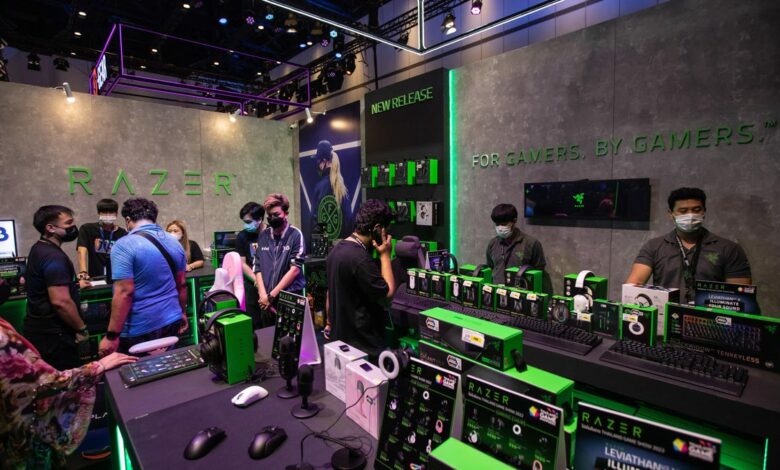Razer says its new AI tool analyzes how products impact the planet in minutes

If you buy a new controller or keyboard, do you know what impact it will have on the environment? Companies do, but it usually takes months to figure it out. Gaming peripheral manufacturer Razer has introduced its own new AI tool, Gaiadex, which apparently reduces this time to just a few minutes.
The new tool breaks down all the components used in a product down to the mineral level and uses AI to analyze and predict environmental impact in less than 5 minutes, Razer says. It’s currently only shared with companies that work with Razer, but it could provide meaningful insights for an industry that releases products full of plastics, metals and rare earth elements that gamers and tech users buy every day. For consumers and businesses increasingly concerned about climate change, greater transparency could lead to more sustainable practices.
This builds on Razer’s previous efforts to add material ‘nutrition labels’ to the boxes of its product range. But Gaiadex is aimed at manufacturers who undergo costly research called life cycle assessments, which can take up to five months and cost hundreds of thousands of dollars, Razer said in a press release. The company also claims that its tool is much more accurate than a traditional LCA, with less margin for error.
A Razer Wolverine V2 Pro controller.
Razer says it has been working over the past two to three years to integrate lifecycle assessments into its workflows and train its AI models, and then started using Gaiadex to learn more about its product line. This opened the company’s eyes to the use of minerals and their complex impact on the environment, causing it not only to change its product strategies but also to protest issues such as the growing global demand for deep-sea mining of precious minerals, said Razer Global Head of Global sustainability Kenneth Ng. Razer wants other companies to make the same discoveries.
“We really want to streamline the work of each brand so that we can all provide a very objective way to measure the impact of our products – not just gaming products, but the entire industry as a whole to restart reporting and give consumers full transparency to give them what they need,” Ng said.
Gaiadex’s analysis is designed to meet standards set by the International Standardization Organization – specifically Type III Environmental Product Declarations that are subject to third-party verification. In other words, it is considered more accurate than that of manufacturers.
Within five minutes, a company can receive a 60-page Gaiadex report, which gives brands independent third-party verification to place an eco-friendly sticker on their product boxes on store shelves if requirements are met. And for its part, Razer wants more partners to use its AI technology tool so that the technology product industry’s understanding of material usage meets these higher standards, resulting in better integrity of the data collected, Ng said.
‘We want to be sure [the data] is absolute and varies as little as possible for the consumer,” said Ng.
Read more: Video games are finally waking up to climate change
Companies submit their bill of materials and fill out form fields about their product, and Gaiadex generates a life cycle assessment estimate in minutes.
Through Gaiadex, the material composition and impact of every accessory on store shelves is improved
Take a standard Razer computer mouse as an example, Ng said, which is made of components like batteries and silicon plates that contain dozens of parts, which themselves can be broken down into materials made up of chemicals and elements. A PCB silicon plate that weighs one-tenth of a pound can contain one-hundredths of a gram of gold, copper and zinc. Ultimately, that mouse’s electronic ingredient list, as the list breakdown is called, could contain about 3,000 different lines.
Small companies can have a hard time making such a material breakdown on their own, so Gaiadex estimates this for them with a margin of error of plus or minus 3% – less than the plus or minus 30% of a traditional LCA, Razer says. . Then the company’s AI tool can compare that material checklist with those of similar products in the industry and alert the manufacturer if it is out of step with the competition.
The point is transparency about how making all these products at scale affects the world.
“Our impact on the environment is not just global warming, which is definitely the hottest thing right now, but we also want to talk about ecological toxicity. [a product] is going to pollute the environment?” Ng said.
Gaiadex estimates how a product affects the environment in several so-called impact categories, including climate change, but also whether it is harmful to human health or contributes to ozone layer depletion and acidification, produces ionizing radiation and what materials and water have been used to create this.
Read more: Internet outages may spread as temperatures rise. This is what Big Tech does
Part of the life cycle assessment that Gaiadex generates is the project impact in various categories shown in these bar charts, including climate change, acidification, freshwater ecotoxicity and water use.
Razer wants partners for more data to fuel Gaiadex – and educate consumers
Razer unveils Gaiadex to the world as it introduces the AI tool at the United Nations COP 29 Environment Conference in Baku, Azerbaijan. The purpose of the conference is partly to encourage the technical accessories industry to adopt the same environmental declaration standards and partly to recruit partners. An important part of creating an AI model that can estimate a life cycle analysis is training it on product data.
Razer has trained Gaiadex on its own lineup, but has worked with partner companies to feed their products’ BOMs into the AI model so that the analysis is industry-specific, sensitive and reliable. One of Razer’s largest partners is GE Healthcare, which helps them perform calculations for healthcare equipment management.
Razer wants to help smaller companies adopt the international standards that Gaiadex uses to start their own LCAs, which can be placed on product labels so consumers can understand the environmental impacts of what they buy. Maybe one day people will be able to easily estimate the cost of the accessories they use as well as the impact of what they eat.
“When you talk about carbohydrates these days, you kind of have an idea of how it’s going to affect your body, but we don’t have the same measurement in our heads for all these different carbohydrates.” [environmental] impact categories,” Ng said.
And what Razer discovered is that gamers actually want this information. In Reddit threads and conversations on X (formerly Twitter), they ask for more specific insights about the products they use. Consumers are very enlightened these days, he said, and are researching publications to understand more — and they can’t be fooled.
For now, Razer is only letting partner companies use Gaiadex, but there is a plan to make it more publicly and easily available by the second quarter of 2025. The more companies adhere to international standards to understand environmental impact, the faster the technology products industry will do so. to avoid past mistakes, Ng believes.
“It took us generations to realize that we need to pay extra attention to the environment. Let’s not make the same mistake we made before. Let’s take a holistic view not just of the carbon footprint, but of the entire spectrum of the impact our products have on the environment,” he says.
Check this out: Sony PlayStation 5 Pro Review: The Most Advanced Gaming Console Ever



